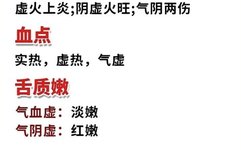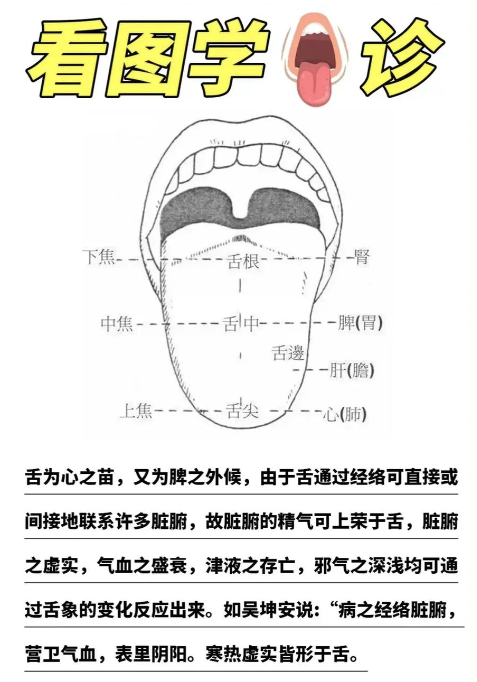
1. Light Purple Tongue
Tongue Quality: Light purple, light white; Shape: Slightly tender, few petechiae, mild tooth marks. Tongue Coating: Thin, moist; Coating Color: White.
【Clinical Significance】Caused by Yang deficiency, Qi deficiency, or Qi stagnation leading to Qi and Blood Stagnation.
2. Flaccid Tongue
Tongue Quality: Light white; Shape: Tender, tooth marks; State: Flaccid. Tongue Coating: Thin, moist; Coating Color: White.
【Clinical Significance】Qi deficiency, Spleen deficiency, Yang deficiency.
3. Mirror Red Tongue
Tongue Quality: Bright red; Shape: Old, cracked. Tongue Coating: Glossy, bare, dry.【Clinical Significance】Yin Deficiency with Excess Heat, or heat injuring Yin fluids, severe damage to Yin fluids.
4. Withered White Tongue
Tongue Quality: Light white, almost bloodless; Shape: Fat, tender, mild tooth marks, few cracks. Tongue Coating: Thin, moist; Coating Color: White.
【Clinical Significance】Yang deficiency, Qi and Blood deficiency, Spleen deficiency; Yang deficiency with water retention, internal dampness.
5. Central Coating Tongue Analysis
Tongue Quality: Slightly red; Shape: Slightly old, few red spots, cracks. Tongue Coating: Slightly thick at the edges, medium coating; Coating Color: Light yellow.
【Clinical Significance】Deficiency with excess: Yin deficiency, phlegm-heat; or phlegm-damp transforming into heat, injuring Stomach Yin.
6. Glossy Red Tongue
Tongue Quality: Bright red; Shape: Tender, glossy red. Tongue Coating: Glossy, medium to severe coating, dry; Coating Color: Slightly white coating at the edges.
【Clinical Significance】Liver-Gallbladder or Spleen-Stomach Damp-Heat (Yang Jaundice); Excess heat injuring Yin, heat invading Ying and Blood Yin fluids.
7. Stagnation Spot Tongue
Tongue Quality: Bright red, local dark purple, petechiae; Shape: Slightly thin, red spots, petechiae, stagnation spots. Tongue Coating: Thick and greasy at the root, slightly dry; Coating Color: White coating.
【Clinical Significance】Blood heat, blood stasis; heat invading Ying and Blood, combined with phlegm-damp.
8. Light Purple Fat Tongue
Tongue Quality: Light purple; Shape: Fat, severe tooth marks, petechiae. Tongue Coating: Thin; Coating Color: White.
【Clinical Significance】Spleen deficiency with phlegm obstruction, Yang deficiency with blood stasis; Qi deficiency with blood stasis, Qi stagnation with blood stasis.
9. Light Purple Tongue with Thick Greasy Coating
Tongue Quality: Light purple, light white; Shape: Tender, petechiae, stagnation spots, mild cracks. Tongue Coating: Wet, slippery, medium thick and greasy; Coating Color: White.
【Clinical Significance】Qi stagnation, Yang deficiency or cold syndrome, phlegm-damp, blood stasis.
10. Red Tip Tongue with Thick Greasy Coating
Tongue Quality: Light white, red tip; Shape: Tender, red spots at the tip, slight cracks. Tongue Coating: Thick, greasy, dry; Coating Color: White.
【Clinical Significance】Qi and Blood deficiency, Yang deficiency, cold-damp transforming into dryness and heat; Yang deficiency with damp obstruction, re-inviting heat evil.
11. Light White Tongue with Slippery Coating
Tongue Quality: Light white; Shape: Slightly tender, cracks. Tongue Coating: Thin and sparse (peeled), slippery; Coating Color: Thin white (slight yellow).
【Clinical Significance】Spleen-Stomach Qi deficiency, Yang deficiency with water flooding.
12. Red Tip Tongue with Thick Greasy Coating
Tongue Quality: Light white, interspersed light purple, red tip; Shape: Slightly tender, red spots at the tip, mild cracks. Tongue Coating: Thick, greasy, dry; Coating Color: White, medium slight yellow.
【Clinical Significance】Spleen Qi deficiency, phlegm-damp accumulation, Qi stagnation with blood stasis; Heart and Lung heat, phlegm-damp transforming into dryness.
13. Accumulated Powder Coating
Tongue Quality: Covered with a thick coating, red spots at the tip; Shape: Red spots at the tip, cracks. Tongue Coating: Full tongue with accumulated powder coating, dry and rough without fluids; Coating Color: White.
【Clinical Significance】Warm Disease (epidemic), sudden evil heat, severe damage to Yin fluids; Yang Qi stagnation.
14. Red Tongue with Yellow Thick Greasy Coating
Tongue Quality: Red; Shape: Slightly old, cracked; State: Mildly tilted. Tongue Coating: Thick, greasy, moist; Coating Color: Yellow, white at the edges.
【Clinical Significance】Phlegm-damp, transforming into heat, transforming into turbidity.
15. Burnt Yellow Coating
Tongue Quality: Red; Shape: Old, red tip cracked. Tongue Coating: Thick, burnt yellow, dry, rough; Coating Color: Yellow.
【Clinical Significance】Evil Qi injuring fluids, dryness binding the bowels.
16. Gray Greasy Coating
Tongue Quality: Light white; Shape: Slightly tender, few stagnation spots, tooth marks. Tongue Coating: Medium thin, thick at the edges, moist, slightly greasy; Coating Color: Edge root gray, medium thin white.
【Clinical Significance】Spleen Qi deficiency, Qi and Blood stagnation; phlegm-damp long-term stagnation, transforming turbidity, transforming heat.
17. Peeled Coating
Tongue Quality: Light white, red at the tip and middle peeling; Shape: Tender, tooth marks, red spots at the tip. Tongue Coating: Medium thick at the root, peeling at the edges, greasy, moist; Coating Color: White, medium root slightly yellow.
【Clinical Significance】Qi and Yin deficiency, Spleen deficiency with damp obstruction; empty fire disturbing internally, or phlegm-damp gradually transforming into heat.
18. Red and Dark Tongue
Tongue Quality: Red with a dark hue; Shape: Thin, with prickly red spots. Tongue Coating: Thin, slightly dry; Coating Color: Slightly yellow.
【Clinical Significance】Internal heat blazing, Heart and Liver fire excess.
19. Light White Tongue
Tongue Quality: Light white; Shape: Tender. Tongue Coating: Thin, moist, root greasy; Coating Color: White.
【Clinical Significance】Qi deficiency, Spleen deficiency, Yang deficiency, phlegm-damp.
20. Red Spot Tongue with Thick Greasy Coating
Tongue Quality: Light red; Shape: Slightly tender, slightly thin, red spots at the tip, stagnation spots. Tongue Coating: Thick, greasy, moist; Coating Color: White.
【Clinical Significance】Heart fire excess, Spleen Qi deficiency, blood stasis, phlegm-damp.
21. Withered White Tongue
Tongue Quality: Light white, almost bloodless; Shape: Tender, thin, mild tooth marks; State: Slightly tilted to the right. Tongue Coating: Thin sparse; Coating Color: White.
【Clinical Significance】Qi and Blood deficiency, Spleen Qi deficiency, Spleen Yang deficiency.
22. Blue-Purple Tongue with Yellow Greasy Coating
Tongue Quality: Blue-purple; Shape: Slightly tender, slightly thin. Tongue Coating: Thick, turbid, moist; Coating Color: Gray, yellow (slightly gray at the tip).
【Clinical Significance】Qi stagnation with blood stasis, phlegm-turbidity with heat, turbid Qi rising.
23. Tongue Bleeding
Tongue Quality: Dark red; Shape: Slightly old, bleeding spots, slight petechiae at the tip. Tongue Coating: Medium thick at the root, greasy, moist; Coating Color: White.
【Clinical Significance】Qi stagnation with blood stasis, phlegm-damp.
24. Slippery Coating
Tongue Quality: Light white (withered white); Shape: Tender, slightly thin. Tongue Coating: Thick, greasy, slippery (water-covered); Coating Color: White.
【Clinical Significance】Yuan Yang deficiency, water damp obstruction.
25. Light Purple Tongue
Tongue Quality: Light white, light purple; Shape: Fat, tooth marks, tender. Tongue Coating: Thick at the root, moist; Coating Color: White.
【Clinical Significance】Yang deficiency, water damp not transforming.
26. Yellow Dry Greasy Peeled Coating
Tongue Quality: Dark red, slightly light purple; Shape: Cracked. Tongue Coating: Thick, greasy, medium root peeling, slightly dry; Coating Color: Yellow.
【Clinical Significance】Allergic constitution, Yin deficiency, phlegm-heat stagnation; or phlegm-heat long-term injuring Yin.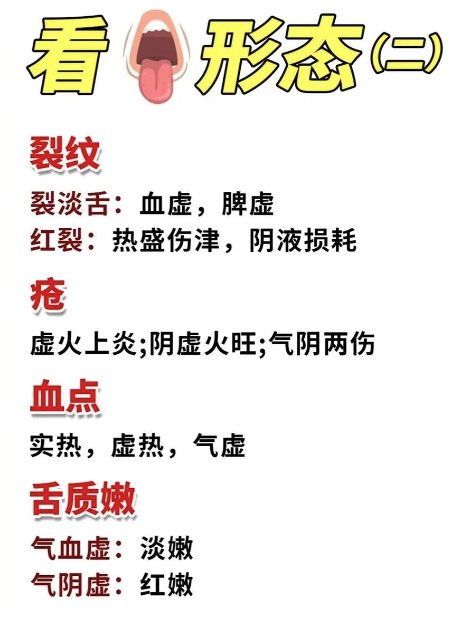
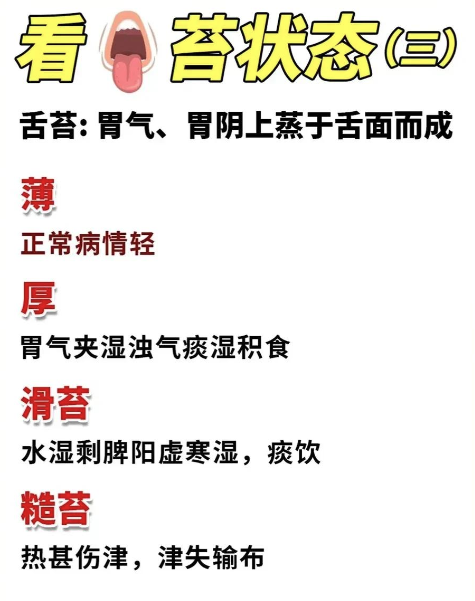
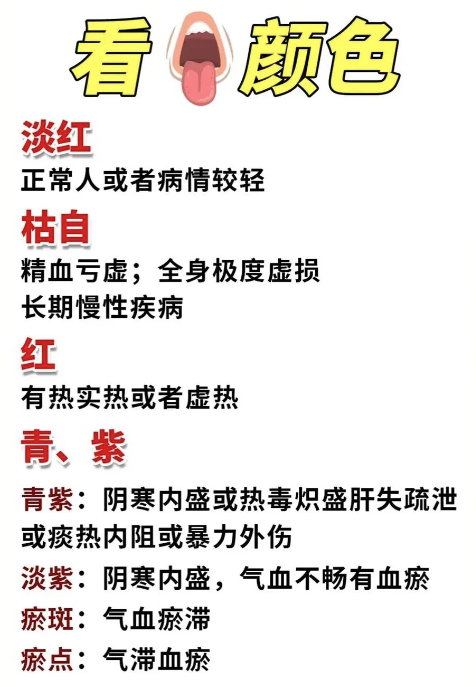
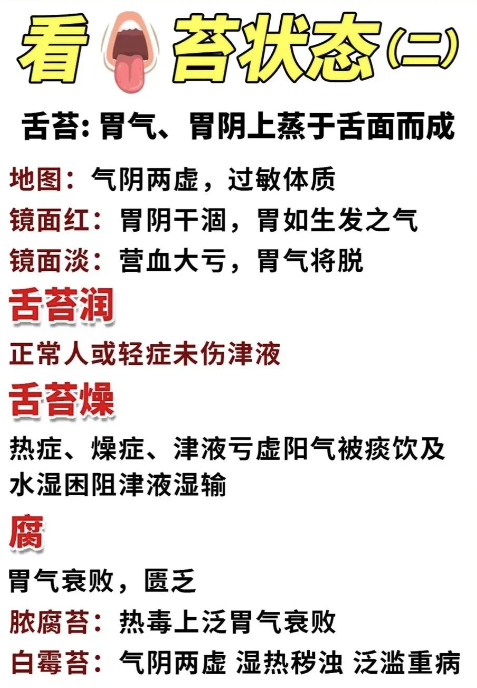

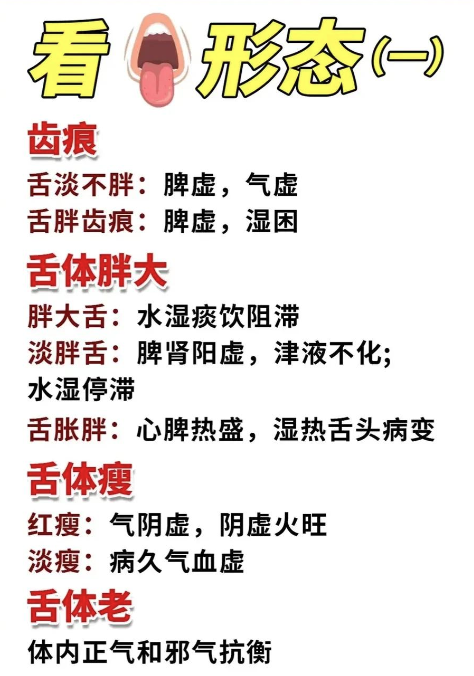
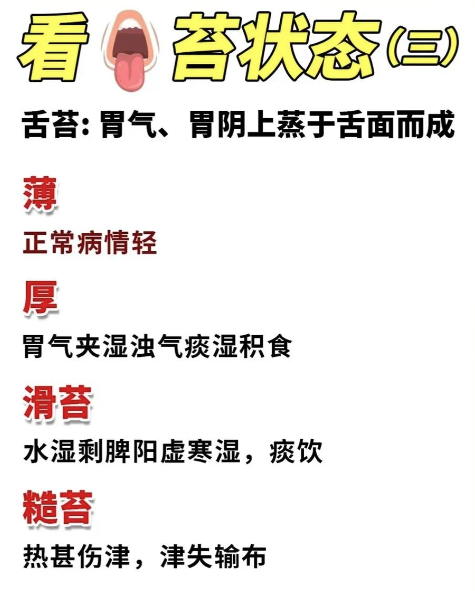
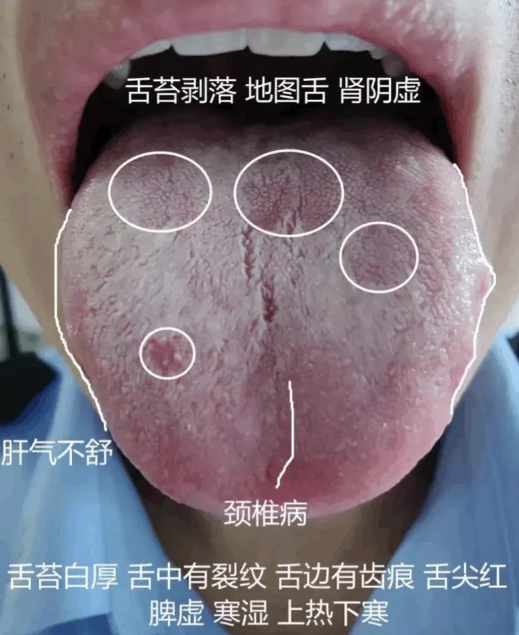 Tongue Diagnosis includes changes in tongue quality and coating. The tongue is a muscular organ composed of mucosa and tongue muscles, attached to the floor of the mouth, mandible, and hyoid bone, and is flat and elongated. Its main functions are to discern taste, regulate sound, mix food, and assist in swallowing. The tongue is composed of muscles, blood vessels, and meridians, all closely related to the internal organs. In TCM, diagnosis emphasizes observation, listening, inquiry, and palpation, with a strong focus on changes in tongue coating. Observing the tongue can help understand and recognize the essence and development of diseases. This is also true for treating stomach diseases, as changes in tongue appearance can reflect certain patterns of Spleen and Stomach disorders. Generally, the pattern of tongue changes is that the coating thickens as the disease progresses and thins as the disease recedes.
Tongue Diagnosis includes changes in tongue quality and coating. The tongue is a muscular organ composed of mucosa and tongue muscles, attached to the floor of the mouth, mandible, and hyoid bone, and is flat and elongated. Its main functions are to discern taste, regulate sound, mix food, and assist in swallowing. The tongue is composed of muscles, blood vessels, and meridians, all closely related to the internal organs. In TCM, diagnosis emphasizes observation, listening, inquiry, and palpation, with a strong focus on changes in tongue coating. Observing the tongue can help understand and recognize the essence and development of diseases. This is also true for treating stomach diseases, as changes in tongue appearance can reflect certain patterns of Spleen and Stomach disorders. Generally, the pattern of tongue changes is that the coating thickens as the disease progresses and thins as the disease recedes.
Tongue Diagnosis Analysis
Thin white coating – early stage of disease, mild, Stomach Qi not harmed. The coating thickens from thin to thick, color changes from white to slightly yellow, and the edges and tip of the tongue change from light red to red – indicating worsening condition, suggesting indigestion, gastrointestinal accumulation of food, etc. The coating changes from white to yellow, and the edges and tip become red – indicating heat signs. The coating changes from yellow to brown, or from brown to black, and becomes dry with little moisture, with the edges and tip turning deep red – indicating excess heat, often leading to dry stools.The tongue coating is thick and white, with a layer of white mucus on the surface – indicating phlegm-damp.The tongue coating is thick and yellow, with red edges and tip – indicating phlegm-heat.The edges and tip of the tongue are red and dark red, even turning purple – indicating phlegm-turbidity and blood stasis.The tongue is red without coating, with a smooth surface like a mirror – indicating Stomach Yin deficiency.The tongue coating is glossy and the tongue quality is light – indicating Qi and Yin deficiency.Based on the different tongue appearances above, combined with other diagnostic methods such as listening, inquiry, and palpation, TCM can conduct a comprehensive analysis and provide individualized treatment based on syndrome differentiation.
Tongue Care
If a person has a thick tongue coating and bad breath for a long time, it generally indicates minor issues with the stomach. If there are no other uncomfortable feelings, one can start by adjusting diet and lifestyle. Maintain a regular lifestyle, keep emotions pleasant and happy, eat easily digestible foods, consume more vegetables and fruits, and avoid greasy and fried foods. It is best to refrain from alcohol and smoking. After a period of adjustment, abnormal tongue coating and bad breath may self-resolve.If the tongue coating is black and greasy, and only the edges and tip are normal light red, with no other obvious discomfort, it may sometimes be a “staining” phenomenon. The patient may have consumed certain colored foods or taken certain medications, which can lead to black coating, and the stool may also appear black; taking antibiotics may also cause black coating. These situations are not pathological and do not require anxiety. However, patients with severe stomach issues should be cautious if they observe black coating; if the edges and tip are deep red or even appear blue or purple, it indicates worsening condition, and they should seek medical attention promptly.Some individuals may have irregular patches of coating on the tongue, with some areas having thin coating and others being smooth without coating, known as “geographic tongue.” This type of tongue appearance, if there are no discomfort feelings, is mostly a physiological change and does not require treatment. If someone with a long-term stomach issue or other chronic disease has never seen this type of tongue appearance before, the appearance of a “geographic tongue” is often a sign of Yin deficiency. While treating the primary disease, one can drink American ginseng tea (9 grams daily, brewed with boiling water, consumed frequently) to promote self-healing.Some individuals may have many “cracks” on the tongue surface, mostly without coating, known as “cracked tongue.” If there are no discomfort feelings, it is also a physiological condition and does not require treatment. If it appears after a severe illness, with a red tongue and no coating, and there are discomfort feelings, it also indicates Yin deficiency and requires medication treatment.Some individuals may have tooth marks on the edges of a fat tongue, with thin white coating. If there are no obvious discomforts, it is due to being overweight. TCM theory suggests that “overweight individuals often have phlegm-damp,” as their Spleen and Stomach functions are relatively insufficient, leading to difficulties in digestion and absorption of food. These individuals should eat less greasy and hard-to-digest foods, consume more vegetables, fruits, and light foods, and exercise appropriately. If the tongue coating is thick and greasy, with tooth marks on the edges, and there is a lack of appetite, abdominal distension, and thin stools, it indicates excessive phlegm-damp, and medication treatment should be combined with a diet of light and easily digestible foods.If someone has a red tongue, thick coating, and constipation, with several days without bowel movements, bad breath, thick tongue coating, red edges and tip, and yellow urine, this indicates excess heat in the stomach. The internal heat in the stomach causes turbid Qi to rise, steaming the mouth and tongue, leading to bad breath, yellow tongue coating, heat injuring fluids, and the intestines losing moisture, resulting in dry stools. At this time, one can take herbs such as Da Huang (Rhubarb), Huang Lian (Coptis), Huang Qin (Scutellaria), and Shan Zhi Zi (Gardenia) to clear heat and drain fire, while avoiding alcohol and spicy hot foods like chili and lamb, and consuming more vegetables, fruits, and light foods, along with plenty of water.
Copyright Notice: The article is sourced from the internet. We share articles and images from the internet, and the copyright belongs to the original author and source. The various prescriptions and formulas mentioned are for reference and learning purposes only and should not be used as a basis for medical diagnosis. Please do not use them blindly, and this platform does not bear any responsibility for any consequences arising from this!

